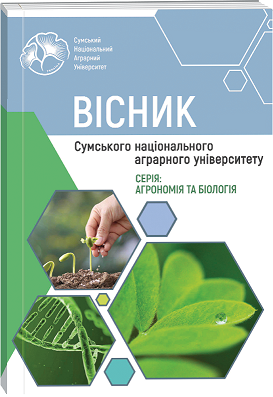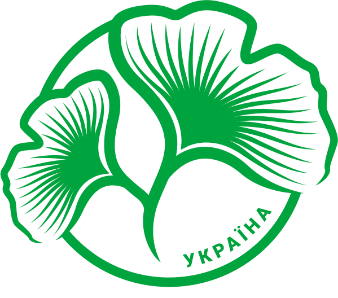INFLUENCE OF LIQUID COMPLEX FERTILIZER FOR VIRUS INFECTION ON SOWING SEED QUALITY AND PRODUCTIVITY OF WHEAT
Abstract
The article is devoted to the research results of the influence of the liquid complex fertilizer «Fiziozhivlin-P» in the formation of productivity elements and sowing qualities of wheat under artificial infection with wheat stripe mosaic virus (WSMV). Methods: Microbiological, molecular genetics, biometric, statistical. In two-year field experiments, the influence of foliar treatment with liquid complex fertilizer (LCF) with a balanced composition of macro and microelements (containing N, P, K, Ca, Mg, S, B, Mn, Zn, Cu, Fe, Mo, Li) of healthy and virus-infected wheat plants (artificial infection) on structural yield indicators, sowing quality of seeds and growth processes of juvenile plants was investigated. The presence of wheat stripe mosaic virus in wheat leaves with WSMV symptoms was confirmed by PCR. Studies have established a significant suppression of the main structural indicators of productivity of common wheat under the influence of WSMV damage: a decrease in the number of productive shoots, stem height, number of spikelets in the spike, length, and number of grains in the main spike, the mass of grains of the main and lateral spike, the mass of 1000 grains. It was found that the treatment of crops of healthy plants with LCF increased mainly the mass of grains of the main and lateral spike. It was found that the mass of juvenile plants grown from seeds of plants treated with liquid complex fertilizer increased significantly, but mainly due to an increase in the root system. The use of LCF during viral infection reduced the negative impact of viral infection on fresh weight gain and growth compared to virus-infected plants without treatment, which occurred due to improved root system growth. The weight of 1000 grains from the yield of virus-infected plants treated with LCF tended to increase to pure control It is noted. Thus, according to the data obtained, foliar treatment of plants with liquid complex fertilizer allows an increase in the tolerance of wheat plants to virus damage, to some extent reducing productivity losses, but it does not affect the sowing quality of seeds and the structure of crop productivity the following year.
References
2. Bhaduri, D., Rakshit, R., & Chakraborty, K. (2014). Primary and secondary nutrients-a boon to defense system against plant diseases. International Journal of Bio-resource and Stress Management, 5(1), 461–467. doi:10.5958/0976-4038.2014.00597.1
3. Bhattacharyya, D., & Chakraborty, S. (2018). Chloroplast: the Trojan horse in plant-virus interaction. Molecular Plant Pathology, 19(2), 504–518. doi: 10.1111/mpp.12533
4. Cabi. Digital Library. Wheat streak mosaic virus (wheat streak). Access mode: https://www.cabi. org/isc/datasheet/56858
5. Chalupníková, J., Kundu, J.K., Singh, K., Bartaková, P. & Beoni, E. (2017). Wheat streak mosaic virus: incidence in field crops, potential reservoir within grass species and uptake in winter wheat cultivars. Journal of Integrative Agriculture, 16, 523–531.
6. Devadas, R., Simpfendorfer, S., Backhouse, D., & Lamb, D. W. (2014). Effect of stripe rust on the yield response of wheat to nitrogen. The Crop Journal, 2, 201–206. doi: 10.1016/j.cj.2014.05.002
7. Dráb, T., Svobodová, E., Ripl, J., Jarošová, J., Rabenstein, F., Melcher, U. & Kundu, J.K. (2014). SYBR Green I based RT-qPCR assays for the detection of RNA viruses of cereals and grasses. Crop and Pasture Science, 65, 1323–1328. doi: 10.1071/CP14151
8. Elmer, W.H, & Datnoff, L.E. (2014). Mineral nutrition and suppression of plant disease, van Alfen N.K. (Ed.), Encyclopedia of Agriculture and Food Systems, Academic Press, 231–244.
9. Faostat. Crops and livestock products. Food and Agriculture Organization of the United Nations. Access mode: https://www.fao.org/faostat/en/#data/QCL/visualize
10. Gauthier, K., Pankovic, D., Nikolic, M., Hobert, M., Germeier, C.U., Ordon, F., Perovic, D. & Niehl, A. (2023). Nutrients and soil structure influence furovirus infection of wheat. Frontiers in Plant Science, 14, 1200674. doi: 10.3389/fpls.2023.1200674
11. Graham, D.R., & Webb, M.J. (1991). Micronutrients and disease resistance and tolerance in plants, 329–370. In Mortvedt, J.J. & Cox, F.R. (Eds). Micronutrients in Agriculture. doi: 10.2136/sssabookser4.2ed.c10
12. Huliaieva, H.B. (2024). Klitynni, fizioloho-biokhimichni i molekuliarno-henetychni mekhanizmy vzaiemodii roslyn i zbudnykiv khvorob riznykh taksonomichnykh hrup. [Cellular, physiological-biochemical, and molecular-genetic mechanisms of the interaction of plants and disease agents of various taxonomic groups]. Physiology of Plants and Genetics, 56(4), 279–310 (in Ukrainian). doi: 10.15407/frg2024.04.279
13. Jones, R.A.C., Coutts, B.A. Mackie, A.E. & Dwyer, G.I. (2005). Seed transmission of Wheat streak mosaic virus shown unequivocally in wheat. Plant Disease, 89, 1048–1050.
14. Kaur, S., Samota, M.K., Choudhary, M., Choudhary, M., Pandey, A.K., Sharma, A., & Thakur, J. (2022). How do plants defend themselves against pathogens-Biochemical mechanisms and genetic interventions. Physiology and Molecular Biology of Plants, 28(2), 485–504. doi: 10.1007/s12298-022-01146-y.
15. Kumar, S., Kumar, S. & Mohapatra, T. (2021). Interaction between macro- and micro-nutrients in plants. Frontiers in Plant Science, 12, 665583. doi: 10.3389/fpls.2021.665583
16. Kumari, V.V., Banerjee, P., Verma, V.C., Sukumaran, S., Chandran, M.A.S, Gopinath, K.A., & Awasthi, N.K. (2022). Plant nutrition: an effective way to alleviate abiotic stress in agricultural crops. International Journal of Molecular Sciences, 31, 23(15), 8519. doi: 10.3390/ijms23158519
17. Lau, S.E., Teo, W.F.A., Teoh, E.Y. & Tan, B.Ch. (2022). Microbiome engineering and plant biostimulants for sustainable crop improvement and mitigation of biotic and abiotic stresses. Discov Food 2, 9. doi: 10.1007/s44187-022-00009-5
18. Markov, I. (2019). Virusni khvoroby zernovykh kolosovykh i zakhody shchodo obmezhennia yikhnoho poshyrennia. [Viral diseases of cereal grains and measures to limit their spread]. Propositiya, 1. (in Ukrainian). Access mode: https://propozitsiya.com/ua/virusni-hvoroby-zernovyh-kolosovyh-i-zahody-shchodo-obmezhennya-yihnogo-poshyrennya
19. Meena V.S., Meena S.K., Verma J.P., Meena R.S., & Ghosh B. N. (2015). The needs of nutrient use efficiency for sustainable agriculture. Journal of Cleaner Production, 102 562–563. doi: 10.1016/j.jclepro.2015.04.044
20. Mishchenko, L., Nazarov, T., Dunich, A., Mishchenko, I., Ryshchakova, O., Motsnyi, I., & Smertenko, A. (2021). Impact of wheat streak mosaic virus on peroxisome proliferation, redox reactions, and resistance responses in wheat. International Journal of Molecular Sciences, 23, 22(19), 10218. doi: 10.3390/ijms221910218
21. Mishchenko, L.T., Dunich, A.A., Mishchenko, I.A., Petrenkova V.P., & Mukha, T.I. (2018). Monitoring of economically important wheat viruses under weather conditions change in Ukraine and investigation of seed transmission of wheat streak mosaic virus. Bulgarian Journal of Agricultural Science, 24, 660–669
22. Nasinnia silskohospodarskykh kultur. Sortovi ta posivni yakosti. Tekh-nichni umovy: DSTU 2240-93. [Seeds of crops. Varietal and showing qualities. Technical conditions: DSTU 2240-93]. K., State Standard of Ukraine, 1994, 73. (in Ukrainian).
23. Pandey, M., Shrestha, J., Subedi, S., & Shah, K.K. (2020). Role of nutrients in wheat: a review. Tropical Agrobiodiversity (TRAB), 1(1), 18–23. doi: 10.26480/trab.01.2020.18.23
24. Paudel, D.B., & Sanfaçon, H. (2018). Exploring the diversity of mechanisms associated with plant tolerance to virus infection. Frontiers in Plant Science, 9,1575. doi: 10.3389/fpls.2018.01575
25. Price, J.A., Workneh, F., Evett, S.R., Jones, D.C., Arthur, J., & Rush, C.M. (2010). Effects of wheat streak mosaic virus on root development and water-use efficiency of hard red winter wheat. Plant Disease, 94, 6, 766–770. doi: 10.1094/PDIS-94-6-0766
26. Singh, K., Wegulo, S.N., Skoracka, A., & Kundu, J.K. (2018). Wheat streak mosaic virus: a century old virus with rising importance worldwide. Molecular Plant Pathology, 19(9), 2193–2206. doi: 10.1111/mpp.12683
27. Sposib pidvyshchennia produktyvnosti pshenytsi ozymoi iz zastosuvanniam ridkoho kompleksnoho dobryva, shcho mistyt khelaty mikroelementiv: pat. 113638 Ukraina MPK [Method for increasing winter wheat productivity using liquid complex fertilizer containing chelates of trace elements: patent 113638 Ukraine MPK] (2016.01) A01C 21/00 C05G1/00 C05D 9/02 (2006.01) C05D 11/00 C05D 11/00. No u 2016 07482; appl. 08.07.2016; publ. 10.02.2017, Bul., 3. 6 p. (in Ukrainian)
28. Sun, Y., Wang, M., Mur, Luis A., Shen, Q., & Guo, S. (2020). Unravelling the roles of nitrogen nutrition in plant disease defences international journal of molecular sciences. International Journal of Molecular Sciences, 21, 572. doi: 10.3390/ijms21020572
29. Tripathi, R., Tewari, R., Singh, K.P., Keswani, C., Minkina, T., Srivastava, A.K., & Sansinenea, E. (2022). Plant mineral nutrition and disease resistance: A significant linkage for sustainable crop protection. Frontiers in Plant Science, 20;13, 883970. doi: 10.3389/fpls.2022.883970.
30. Velasquez, A.C., Castroverde, C., & He, S.Y. (2018). Plant-pathogen warfare under changing climate conditions. Current Biology, 28, 619–634. doi: 10.1016/j.cub.2018.03.054
31. Wang, M., Zheng, Q., Shen, Q., & Guo, S. (2013). The critical role of potassium in plant stress response. International Journal of Molecular Sciences, 14, 7370–7390. doi: 10.3390/ijms14047370

 ISSN
ISSN  ISSN
ISSN 



